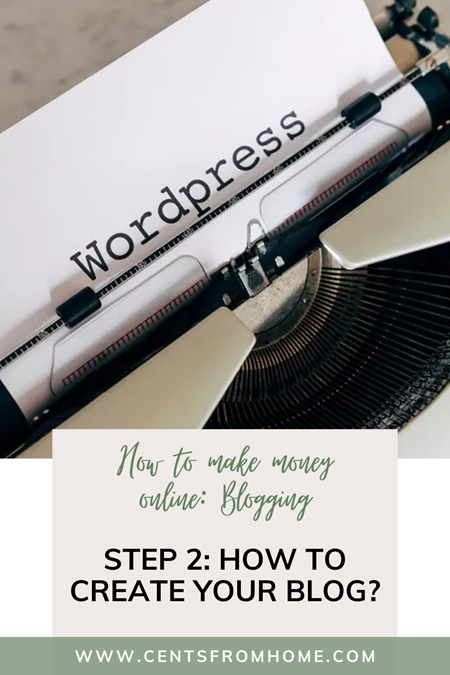Step 5: How to monetize your blog?

Introduction
Most bloggers are hoping to eventually turn their blogs into a source of income, and there are many different ways on how to monetize your blog. Some of the most popular methods include: advertising on your blog, sponsorships from other businesses, affiliate marketing programs, and selling your own products or services through your blog. Let’s take a closer look at each of these methods so you can decide which ones might work best for your blog.
Ads

One way that bloggers make money is by selling advertising space on their blog. This can be done through a direct ad sale, where you agree to sell a certain amount of space on your blog to an advertiser in exchange for a flat fee. Or you can turn to a third-party ad network, which helps match up advertisers with bloggers in an auction-based system, sometimes at a cost-per-click or cost-per-impression basis.
- PPC/CPC: cost-per-click or cost-per-impression model. In this model de advertiser pays you based on how many clicks your ad receives or how many times it is viewed by readers. This type of advertising can be beneficial for bloggers because the advertiser only pays for results, rather than simply paying for ad space.
- CPM: With a cost-per-mile, or CPM, advertising model, advertisers will pay you based on how many times their ad is shown on your blog, regardless of whether anyone clicks on it. This type of advertising can be good for bloggers who have a lot of traffic to their site but may not necessarily have high click-through rates.
Types of Ads
There are a number of different types of ads that bloggers can choose to display on their sites. The most common type is a contextual ad, meaning the content of your blog is analyzed and matched up with relevant advertisements that are then served to visitors to your site. Other common types include specific placement ads (where you agree to place an advertisement in a specific location on your blog, such as at the top of every page), and targeted advertising (which is based on demographic data, interests, or other factors to create ads that are more likely to be relevant and engaging for readers).
Tips for making money with ads
1. Keep your audience in mind: When choosing ads to display on your blog, it’s important to think about what type of ad would be most relevant and engaging for your readers. If you have a food blog, for example, you may want to consider partnering with a food-related advertiser.
2. Don’t go overboard: It’s important to strike a balance when it comes to the number of ads you display on your site. If you have too many ads, it can make your blog look cluttered and turn readers off. On the other hand, not enough ads can make it difficult to generate enough revenue to sustain your blog over time.
3. Pay attention to placement: Where you place your ads on your blog can make a big difference in terms of both revenue and reader engagement. Experiment with different placements to see what works best for your blog and your audience.
4. Monitor your results: Be sure to keep an eye on your click-through rates and other metrics to see how well your ads are performing. If you notice that certain ads are not generating a lot of clicks or revenue, you may want to consider replacing them with new ones.
Affiliate Marketing

Another way that many bloggers generate income is through affiliate marketing programs, which involve promoting certain products or services on your blog and earning a commission on any sales that you generate.
For example, let’s say you have a blog about fashion. You could team up with an online retailer that sells clothing and promote their products on your site. If someone clicks on one of your links and makes a purchase, you would earn a commission on that sale.
How does affiliate marketing work?
Affiliate marketing programs typically use one of two models: pay-per-sale or pay-per-lead. With a pay-per-sale model, you earn a commission on any sales that you generate. With a pay-per-lead model, you earn a commission on any leads that you generate, such as people who fill out an online form or sign up for a mailing list.
One way to monetize a blog with affiliate marketing is to partner with other brands and websites in your niche. Affiliate programs allow you to earn a commission each time someone makes a purchase through your referral link, typically ranging from 5-30% of the total sale value. To get started with affiliate marketing, you can look for companies that offer affiliate programs in your niche, and then apply to be an affiliate. Once you’re approved, you’ll receive a unique referral link that you can share on your blog and social media channels. If someone clicks on your link and makes a purchase, you’ll earn a commission from the sale.
Tips for making money with affiliate marketing
1. Join relevant affiliate programs: When choosing which affiliate programs to join, be sure to select ones that are relevant to your blog’s content and audience. For example, if you have a blog about fashion, you would want to affiliate with retailers that sell clothing and accessories.
2. Promote products that you believe in: It’s important to only promote products that you actually like and use yourself. This way, you’ll be able to provide honest reviews and recommendations that will be helpful for your readers. Additionally, if you don’t believe in the product, it will be difficult to convince others to purchase it.
3. Use multiple affiliate programs: Rather than relying on a single affiliate program for all of your blog’s income, it’s a good idea to join several different programs. This will help diversify your income streams and ensure that you have multiple ways to monetize your blog.
4. Grow your audience: As with any other type of online marketing, the more people you can reach with your affiliate links, the more likely you are to generate sales. Focus on growing your blog’s traffic and expanding your reach through social media and other marketing channels.
5. Be transparent: When sharing affiliate links on your blog, be sure to disclose that you are doing so. This will build trust with your readers and help them understand that you are monetizing your blog. Additionally, be sure to clearly state that you are not being paid to promote a product unless you have explicitly agreed to do so.
Sponsored Content

Sponsored content is a form of advertising in which brands pay bloggers to promote their products or services on their blog. This can take the form of a review, giveaway, or simply an endorsement. In most cases, sponsored posts will be clearly marked as “sponsored” or “ad” so that readers are aware that the content is promotional.
To monetize your blog with sponsored content, start by building up a loyal audience through high-quality content and engaging with your readers on social media and other marketing channels. You can then reach out to brands or companies that are a good fit for your blog’s audience, pitching them your ideas for sponsored posts or offering to write a review of their product or service.
When negotiating your rate for a sponsored post, be sure to consider the amount of traffic your blog receives, the size of your audience, and the level of engagement you have with your readers. You should also keep in mind that sponsored posts take time to create, so be sure to factor in the cost of your time when determining your rate.
Some bloggers also make money by accepting sponsored blog posts from other businesses that provide free products or services in exchange for ad space on the blog. This is one of the most common types of advertising used on blogs today and is quite popular among lifestyle and fashion bloggers, who often review new products and services on their sites.
What are the benefits of using sponsored content as a way to monetize your blog?
There are several benefits to using sponsored content to monetize your blog. Firstly, it can help you build relationships with brands or companies that are a good fit for your audience. By working directly with these businesses, you can help promote their products or services and drive more sales. Secondly, sponsored content can be a great way to earn income from your blog without having to rely on advertising or affiliate marketing. And finally, it can help you add more variety to the content on your blog, keeping readers engaged and coming back for more.
Tips for making money with sponsored content
1. Do your research. Before you start working with brands or companies, it’s important to do your research and make sure that their products or services are a good fit for your blog. This will help to build trust with your audience and prevent any negative associations with paid advertising.
2. Be transparent. Make sure that any sponsored posts or content are clearly marked as “sponsored” or “ad” so that your readers know that you have received compensation for creating the content. This will help to build credibility with your audience and prevent any negative associations with paid advertising.
3. Choose the right brands. Not all brands will be a good fit for your blog, so it’s important to do your research and only work with brands that are a good match for your audience. This will help to avoid any negative associations with paid advertising, as well as driving more sales or engagement from your readers.
4. Keep experimenting. As you continue to build up your blog and your audience, don’t be afraid to experiment with different ways of monetizing. This can help you to stay engaged and keep your blog growing over the long-term. Whether it’s through sponsored content, affiliate marketing, or another method entirely, there are many ways to make money from a blog. So keep trying new things and see what works best for you and your audience.
Creating and Selling Products
Another way to monetize your blog is by selling products or services directly to your readers. This could include digital products such as ebooks or online courses, physical goods such as artisanal goods or handmade jewelry, or even services such as coaching or consulting. If you have a niche or specialist knowledge, this can be a great way to capitalize on your expertise and generate income from your blog.
There are a few key steps that you can take to successfully create and sell products through your blog. Firstly, it’s important to do market research and identify the needs of your audience. This will help you to develop products that are a good fit for their interests and will resonate with your readers.
Next, you need to develop a marketing strategy for promoting your products. This might include things like creating promotional content on your blog, email marketing campaigns, or social media promotion. It’s also important to think about pricing and distribution, as well as any customer support or maintenance that will be necessary once your products are up and running.
Overall, if you are passionate about a topic and want to share your knowledge with others, creating and selling products can be a great way to monetize your blog. Just make sure to do your research and planning beforehand so that you can set yourself up for success.
Digital Products

One popular way to monetize a blog is by selling digital products. This could include anything from e-books and online courses to printables and graphics. If you have expertise in a particular area or niche, this can be a great way to share your knowledge with others and generate income from your blog. To do this successfully, it’s important to identify the needs of your audience and create products that are relevant and valuable to them.
Types of digital products
- Ebooks: How-to guides, novels, cookbooks, etc.
- Courses: Video lessons, audio recordings, PDFs, etc.
- Graphics: Images, icons, illustrations, etc.
- Printables: Planners, worksheets, checklists, digital invitations, etc.
- Digital art: Photos, illustrations, etc.
- Templates: Web themes, email templates, etc.
Tips for making money with digital products
Here are a few tips to help you make money from digital products:
1. Do your research. Before creating any digital products, it’s important to do your research and understand the needs of your audience. This will help you to create products that are relevant and valuable to them, and more likely to sell.
2. Develop a marketing strategy. To successfully sell your digital products, it’s important to have a strong marketing strategy. This might include things like creating promotional content on your blog, email marketing campaigns, social media promotion, and more.
3. Think about pricing and distribution. When determining the price for your digital products, it’s important to consider the time and effort that went into creating them. You’ll also need to think about how you will distribute your products, whether it’s through a digital download or physical shipping.
4. Offer customer support. Once you start selling digital products, it’s important to offer some level of customer support to your readers. This might include things like email support, troubleshooting guides, or other resources that can help to address any questions or issues that your customers may have.
Ultimately, if you are passionate about a topic and want to share your knowledge with others, selling digital products can be a great way to make money from your blog.
Physical Products

Another popular way to monetize a blog is by selling physical products. Many bloggers create and sell their own physical products, such as clothing, accessories, jewelry, or home decor items. This can be a great way for bloggers to build an online store and generate revenue from their blog.
Tips for making money with physical products
1. Develop a strong brand and online presence. Creating a strong brand is essential when selling physical products on your blog. This includes things like developing a unique aesthetic and voice for your brand, establishing a social media presence, and building up an audience of loyal followers who are interested in your products.
2. Research your target market and product demand. In order to be successful when selling physical products on your blog, it’s important to do your research and understand the needs and interests of your target market. This will help you to create products that are relevant and appealing to them, which can increase sales and revenue from your blog.
3. Create high-quality products. When selling physical products on your blog, it’s important to focus on creating high-quality items that are well-made and appealing to your target market. This can help to increase sales and encourage customers to return to your blog in the future.
4. Promote your products effectively. Once you’ve developed your products, it’s important to promote them effectively on your blog and through other online channels. This might include things like social media marketing, email outreach campaigns, or paid advertising.
If you’re interested in selling physical products on your blog, there are a number of platforms and tools that can help. Some popular options include Shopify and Etsy, which allow you to set up an online store and manage all aspects of your products and sales. Additionally, there are many marketing tools that can help with promoting your products effectively, such as social media management software or email marketing platforms.
Online courses and workshops

A popular way to monetize a blog is through online courses and workshops. Many bloggers create in-depth, high-value courses and workshops that help their audiences learn new skills or gain valuable knowledge on a particular topic. This can be a great way to build your audience, generate revenue from your blog, and help others in the process.
Tips for making money with online courses and workshops
1. Do your research. As with any type of product, it’s important to do your research and understand the needs of your audience before creating an online course or workshop. This will help you to create something that is relevant and valuable to them, and more likely to sell.
2. Create quality content. When creating an online course or workshop, it’s important to focus on quality over quantity. This means creating comprehensive, well-structured content that will provide value to your audience.
3. Promote your course. Once you’ve created your course or workshop, it’s important to promote it effectively. This might include things like email marketing, social media promotion, pay-per-click advertising, and more.
4. Provide customer support. Once you start selling your online courses and workshops, it’s important to offer some level of customer support to your students. This might include things like email support, troubleshooting guides, or other resources that can help to address any questions or issues that your students may have.
If you’re interested in creating and selling online courses or workshops, there are a few platforms that can help you to do this, such as Teachable, Skillshare, and Udemy.
Coaching and consulting

Another popular way to monetize a blog is by offering coaching and consulting services. This can be a great way to generate revenue from your blog while helping others to achieve their goals.
Tips for making money with coaching and consulting
1. Define your target market and niche. When offering coaching and consulting services on your blog, it’s important to define your target market and niche. This will help you to focus your services and ensure that they are relevant and valuable to your audience.
2. Create a comprehensive service offering. In order to be successful with coaching and consulting on your blog, it’s important to develop a comprehensive service offering that meets the needs and interests of your target market. This may include things like one-on-one coaching, group workshops or webinars, online training programs, or consulting sessions.
3. Build up an audience of potential clients. In order to generate revenue from your blog through coaching and consulting, it’s important to build up an audience of potential clients. This can be done through things like social media marketing, email marketing, or content marketing.
4. Promote your services effectively. Once you’ve developed your services, it’s important to promote them effectively on your blog and through other online channels. This might include things like social media marketing, email outreach campaigns, paid advertising, or content marketing.
There are many tools and platforms available to help you successfully monetize your blog through coaching and consulting services. Some popular options include online course platforms like Teachable or Thinkific, as well as marketing tools like email service providers or social media management software.
Freelance Services

There are many different types of freelance services that bloggers can offer to their audiences, such as writing or editing services, design and web development work, social media marketing support, online marketing consulting, and more. Some key considerations when choosing which freelance services to offer on your blog include your target market and niche, the skill set required for each service, and the demand for each service within your target market.
Tips for making money with coaching and consulting
1. Define your target market and niche. When offering freelance services on your blog, it’s important to define your target market and niche. This will help you to focus your services and ensure that they are relevant and valuable to your audience.
2. Create a comprehensive service offering. In order to be successful with offering freelance services on your blog, it’s important to develop a comprehensive service offering that meets the needs and interests of your target market. This might include things like writing or editing services, design and web development work, social media marketing support, or online marketing consulting.
3. Build up an audience of potential clients. In order to generate revenue from your blog through freelance services, it’s important to build up an audience of potential clients. This can be done through things like social media marketing, email outreach campaigns, or content marketing.
4. Promote your services effectively. Once you’ve developed your services, it’s important to promote them effectively on your blog and through other online channels. This might include paid advertising, social media marketing, email outreach campaigns, or content marketing.
There are many tools and platforms available to help you successfully monetize your blog through freelance services. Some popular options include online job boards like Upwork or Freelancer, as well as marketing tools like email service providers or social media management software.
Paid Directory
Another popular way to monetize a blog is by creating and operating a paid directory. A paid directory is essentially an online listing of businesses or organizations in a particular industry or niche, often organized by category or location. This can be a great way to generate revenue from your blog while helping others to connect with relevant services and resources.
There are several key strategies that you can use to effectively monetize your blog with a paid directory. These include focusing on a specific niche or industry, regularly updating and adding new listings, working with advertisers and sponsors, offering premium membership subscriptions, and using targeted marketing and SEO techniques. Additionally, it’s important to be strategic about the pricing of your listings, as this will impact the overall profitability of your directory.
Paid Memberships
Another popular way to monetize a blog is through paid memberships. With this model, bloggers offer exclusive content, resources, or benefits to their readers in exchange for a monthly or annual subscription fee. This can be a great way to build engagement and loyalty among your readers, while also generating additional revenue for your blog.
Paid memberships can typically be started once you’ve built up a loyal following and have established yourself as an expert in your field. This will help to ensure that your content is valuable and relevant to your audience, which in turn can help to drive subscription sales and increase revenue. Additionally, it’s important to actively grow your membership base by using targeted marketing and SEO techniques, as well as offering incentives or discounts for early sign-ups.
Whether you’re just starting out or you’ve been blogging for years, there are many different ways that you can monetize your blog and generate revenue from your site. Some of the most popular monetization strategies include displaying ads, partnering with sponsors, and selling your own products or services. Ultimately, the key is to find a monetization strategy that works best for you and your audience so you can continue growing your blog and earning money over time. Thanks for reading!
Check other posts from this guide
How to make money online: Blogging
Step 1: Getting started to start a blog
Step 2: How to create your blog?
Step 3: How to create content for your blog?
Step 4: How to promote your blog?
Step 5: How to monetize your blog?
Related Posts
Affiliate Marketing Explained: A Beginner’s Guide
Choosing the Right Affiliate Programs: Tips for Women Bloggers
Affiliate Marketing vs. Sponsored Posts: Pros and Cons
Content that Converts: Writing Effective Affiliate Marketing Posts
The Art of Affiliate Link Placement: Maximizing Click-Through Rates
Building Trust with Your Audience: The Key to Affiliate Success







